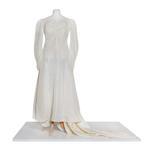Bridal dress
Production date
Circa 1940s
Audio tour
See full details
Details
Description
A white wedding gown made from the silken material of a Second World War British parachute, found in the Cardiff Office of the British Red Cross in 2017.
The outbreak of war in 1939 saw an increased pressure on the British textile industry as men and women rushed to sign up to the armed forces or voluntary services to aid in the war effort. Almost one in four British citizens were issued with a uniform, and by 1941, the British government felt it was necessary to limit the production of civilian clothing in order to protect the raw materials needed for the armed forces. A clothing ration was declared on June 1st.
Britain had launched the ‘Make Do and Mend’ campaign in 1943 to attempt to get the British population to make their existing clothing last longer. As this bridal dress illustrates, inventiveness, innovation and ingenuity was vital during a period of scarcity in order to maintain wedding traditions.
Creating wedding gowns from parachute material became a trend that swept Europe, the United States and Australia during the final years of the war and into the post-war period. Many servicemen gifted their prized silk or nylon parachutes to their brides and it became popular for women to transform them into clothing such as undergarments, night dresses and wedding dresses like the one pictured. On a practical level, it made sense to recycle this material during a period of scarcity, but on a symbolic level, many felt that it was also a patriotic way to honour the service of their husband by creating the clothing out of the material and wearing it on their wedding day.
I was drawn to this wedding dress because of the extraordinary lengths that many women went to in order to maintain tradition despite the tumultuous circumstances and shortage in material. Hardship and scarcity was met with imagination and resourcefulness and many beautiful pieces of clothing were created despite the difficulty in obtaining materials.
Audio recording by Jake Gill (volunteer), Manchester.
The outbreak of war in 1939 saw an increased pressure on the British textile industry as men and women rushed to sign up to the armed forces or voluntary services to aid in the war effort. Almost one in four British citizens were issued with a uniform, and by 1941, the British government felt it was necessary to limit the production of civilian clothing in order to protect the raw materials needed for the armed forces. A clothing ration was declared on June 1st.
Britain had launched the ‘Make Do and Mend’ campaign in 1943 to attempt to get the British population to make their existing clothing last longer. As this bridal dress illustrates, inventiveness, innovation and ingenuity was vital during a period of scarcity in order to maintain wedding traditions.
Creating wedding gowns from parachute material became a trend that swept Europe, the United States and Australia during the final years of the war and into the post-war period. Many servicemen gifted their prized silk or nylon parachutes to their brides and it became popular for women to transform them into clothing such as undergarments, night dresses and wedding dresses like the one pictured. On a practical level, it made sense to recycle this material during a period of scarcity, but on a symbolic level, many felt that it was also a patriotic way to honour the service of their husband by creating the clothing out of the material and wearing it on their wedding day.
I was drawn to this wedding dress because of the extraordinary lengths that many women went to in order to maintain tradition despite the tumultuous circumstances and shortage in material. Hardship and scarcity was met with imagination and resourcefulness and many beautiful pieces of clothing were created despite the difficulty in obtaining materials.
Audio recording by Jake Gill (volunteer), Manchester.
Collection Type
Objects
Catalogue Number
3232/1
Subject auto tags
Object Types
Part of 1 highlight set
Share
All images are the property of the British Red Cross Museum and Archives (unless otherwise indicated), and cannot be used without permission. For queries about permission to use images, please contact enquiry@redcross.org.uk.


-1%20(002).jpg)